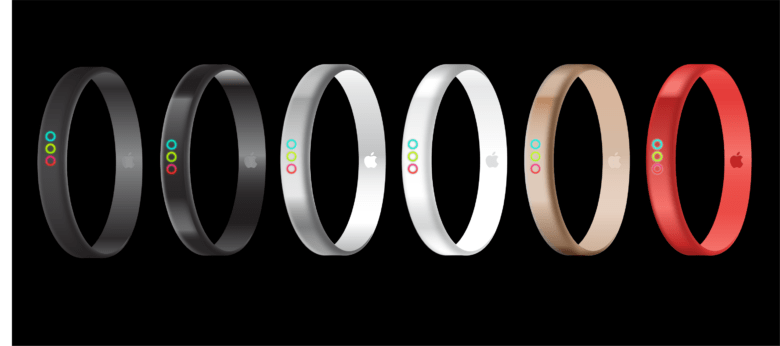The Activity app is one of Apple’s most important and powerful products. Its three brightly colored rings are changing people’s lives around the world, inspiring individuals to make healthier choices throughout their day.
The trouble is, if you want to use the Activity app, your only option right now is to buy an Apple Watch — and Apple Watches are expensive.
With this kind of game-changing product, Apple usually wants to reach as big an audience as possible. Take the iPod, for example. It was too expensive for some consumers. so Apple released a no-frills, sub-$99 version called the iPod Shuffle. Could a similar strategy work for the Activity app? An affordable activity band from Apple could be a Fitbit killer.
Predicting Apple’s next move
Back in 2015, I predicted Apple and Nike would release a joint-branded watch. I even did a mockup to show what I thought it would look like.
Ten months later, Apple released something remarkably similar. Since that prediction turned out pretty well, I thought I’d give it another go this year. These mockups are not based on any insider knowledge. It’s all just speculation for fun.
Apple Band: No buttons. No display. Just three LEDs.
Unlike Apple Watch, which does everything from paying your restaurant bills to checking your messages, this concept for an Apple Band does one thing and one thing only: It tracks your daily activity.
It doesn’t need all of the Apple Watch’s fancy features. There’s no Retina display. No Multi-Touch support. No Digital Crown. No buttons at all, in fact.
Instead, Apple Band is simply equipped with an accelerometer to detect your movement, a sensor to monitor your heart rate, Bluetooth to send the data to your phone, and three colored LEDs that light up to indicate when you complete your rings. You manage the device entirely from the Activity app on your iPhone.
Keeping things simple would not just make Apple Band affordable — it could also make the battery last longer. Such a device could conceivably run for a full week on a single charge, so you wouldn’t need to take it off at bedtime.
An Apple fitness tracker wrapped in plastic

Image: Graham Bower/Cult of Mac
These Apple fitness tracker mockups are inspired by the classic styling of Nike’s FuelBand. Which seems logical, since the design of the Activity app itself is reminiscent of the Nike Fuel ring.
The Apple Band design would be similar to those charity bracelets that surged to popularity in the ’90s.. The material would need to be cheap to hit the crucial $99 price point, so you’ll find no steel or even aluminum here. Instead, the whole thing wold be sealed in waterproof rubberized plastic. The LEDs would sit just below the surface of the rubber, so the light could pass through it.
All the electronics could reside in one side of the strap, allowing the other side to be stretchy to accommodate different wrist sizes while delivering the snug fit needed for the heart-rate monitor. Still, different sizes would be required to fit every wrist.
Killer feature: Automatic workout detection
One drawback of not having any buttons on on the bracelet is that there’s no way to start a workout. But this would be solved if Apple added automatic workout detection. When your movement and heart rate increase beyond a certain threshold, the workout-tracking mode would be triggered automatically.
The band could automatically detect what type of workout you are doing by sensing the movement patterns of your wrist (using software like FocusMotion). Alternatively, if you are a runner, for example, you could simply tell the Activity app to log all your workouts as running workouts.
And so as not to leave Apple Watch users behind, this feature could be introduced to watchOS 4 as well. So when your movement and heart rate increase, your Apple Watch automatically launches the Workout app and starts gathering workout data.
Would Apple release a product that could cannibalize Watch sales?
There’s really only one big reason I can think of that wouldn’t Apple release this type of low-cost fitness tracker: Why would Cupertino “give away” its crown jewels in a budget device and potentially cannibalize Apple Watch sales?
That is certainly a risk. But I would argue that this is what Apple always does. Where would Apple be today if it had not launched the iPhone over worries about cannibalizing iPod sales? Or if the company scrapped the iPad because the move could harm Mac sales?
Apple never holds back on innovation just to protect the status quo. The company focuses on making great products that delight its customers. And that is why Cupertino avoids getting caught by the “innovator’s dilemma,” which happens when a company becomes so invested in its old products that they resist adopting new innovations and eventually become obsolete.
Ultimately, an Apple Band would be a companion product to the iPhone anyway. While a low-cost Apple fitness tracker might mean a short-term negative impact on Apple Watch sales, it would enhance the iPhone product proposition. (And the iPhone is, after all, Apple’s most profitable product.)
Once new users get a taste of the Activity app with an Apple Band, they might well choose to upgrade to an Apple Watch in the future.


